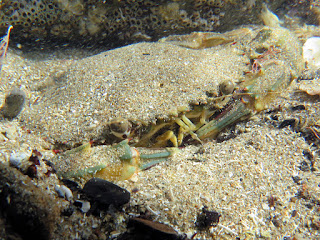I took a lot of pictures during my doctoral research, most of which I didn’t end up using for anything. Occasionally though, I would stumble upon something interesting, and by interesting I mean horrific.
 |
A parasitic copepod attaching through the
body wall of a notable rattail. |
Fish are often beset by parasites, not only internally, but also externally. Some of the external ones can be quite hideous. In this instance a notable rattail (
Coelorinchus innotabilis, McCullock, 1907) has been attacked on its underside by a parasitic copepod. Copepods are crustaceans and these belong in the Order Siphonostomatoida and within that, probably the family Sphyriidae.
Sphyriid copepods attach through (yes, that’s
through) the body wall of the fish by means of an anchored stalk and feed on the fish’s bodily fluids. The part you see on the outside is the body of the copepod and it’s reproductive parts ( ~1 cm).
These particular copepod parasites are thought to only attack fishes that live close to the bottom and this feature can be used to ascertain details regarding the fish’s habits in lieu of other information. This was corroborated by the diet of this species, as notable rattails are bottom feeders (Jones 2008).
 |
| Notable rattail, NE Chatham Rise, 901m |
 |
Notable rattail, NE Chatham Rise, 901m.
Dorsal view. |
 |
Notable rattail, NE Chatham Rise, 901m.
Ventral view. |
Don’t worry though, as these parasites don’t attack people (as far as I know). Plus, they tend to live in deep-water and if you happen to find yourself down at 1000m you probably have bigger problems.
As for the fish itself, rattails are
ubiquitous in the deep-sea and about sixty species occur in New Zealand waters. Notable rattails live at an average depth of 985m (Anderson, et al. 1998), so most people won't have seen one. These came from a research trawl for orange roughy, which occurred on northeastern Chatham Rise, during July 2004 (Thanks go to
NIWA).
Notable rattails feed on small invertebrates, which they pick from the sea bed (Jones, 2008). As such, they play an important role in the structuring of demersal (near the bottom) communities.
More info:
Anderson OF, Bagley NW, Hurst RJ, Francis MP, Clark MR, McMillan PJ 1998. Atlas of New Zealand fish and squid distributions from research bottom trawls. NIWA Technical Report 42.
Doonan IJ, Dunn MR, Dunford A, Hart AC, Tracey D 2006. Acoustic estimates of
orange roughy abundance on the northeastern and eastern Chatham Rise, July
2004: wide-area and hill survey. New Zealand Fisheries Assessment Report 58.
Jones MRL 2008. Dietary analysis of
Coryphaenoides serrulatus,
C.
subserrulatus and several other species of macrourid fish (Pisces: Macrouridae) from northeastern Chatham Rise, New Zealand. New Zealand Journal of Marine and Freshwater Research 42: 73–84.

































